Morris & Fan. Reservoir Sedimentation Handbook
Подождите немного. Документ загружается.

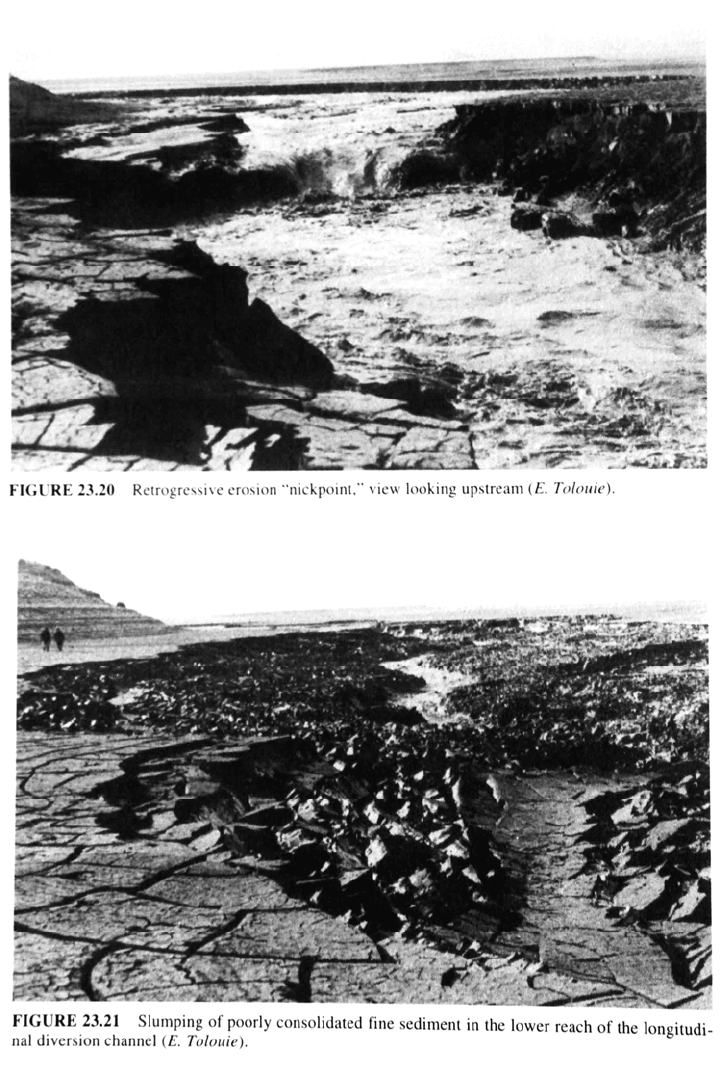
CASE STUDY: SEFID-RUD RESERVOIR, IRAN 23.23
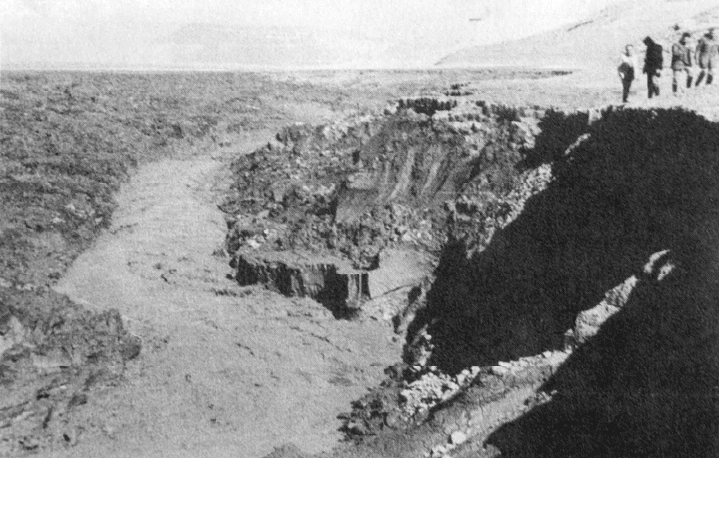
CASE STUDY: SEFID-RUD RESERVOIR, IRAN 23.24
FIGURE 23.22 Steep banks of consolidated sediment in the middle reach of the diversion channel
during active erosion period (E. Tolouie).
r
eached a stable geometric configuration by late December 1989, after about 95 days of
diversion flow.
Fifty cross-section measurements of the diversion channel taken in January 1990,
after it appeared to have stabilized, showed it to have an irregular geometry. Most of the
cross sections had a combined section geometry consisting of a deeper main channel with
a shallower and wider terraced channel on either one or both sides, created by the layers
of cohesive sediment within the deposits. Channel top width varied from about 50 m to
200 m. The final stable condition in the middle reach is shown in Fig. 23.23, illustrating
the deep main channel bordered by flat terraces and the pronounced tendency to create a
meandering planform.
23.6.5 Prediction of Channel Width
Tolouie (1993) used many regime and tractive force equations to compute the
equilibrium width of the diversion channel based on the soils data available from the
extensive boring program, discharge, and slope. The diversion channel geometry at Sefid-
Rud consisted of a terrace section in which the slope was defined by the top of the thick
cohesive sediment layer, and a deeper section whose slope was fixed by the main channel
elevations at the beginning and the end of the diversion channel. These two slopes were
used to compute the widths within the upper and lower channel sections. The
computational procedure is given in Chap. 15.
In general. it was found that the regime-type equations underestimated the width of
the eroded channel, apparently because the canals from which regime equations were
derived are quite different from the conditions in sediment deposits. More reasonable
results were achieved with tractive force methods. However, considerable field data are
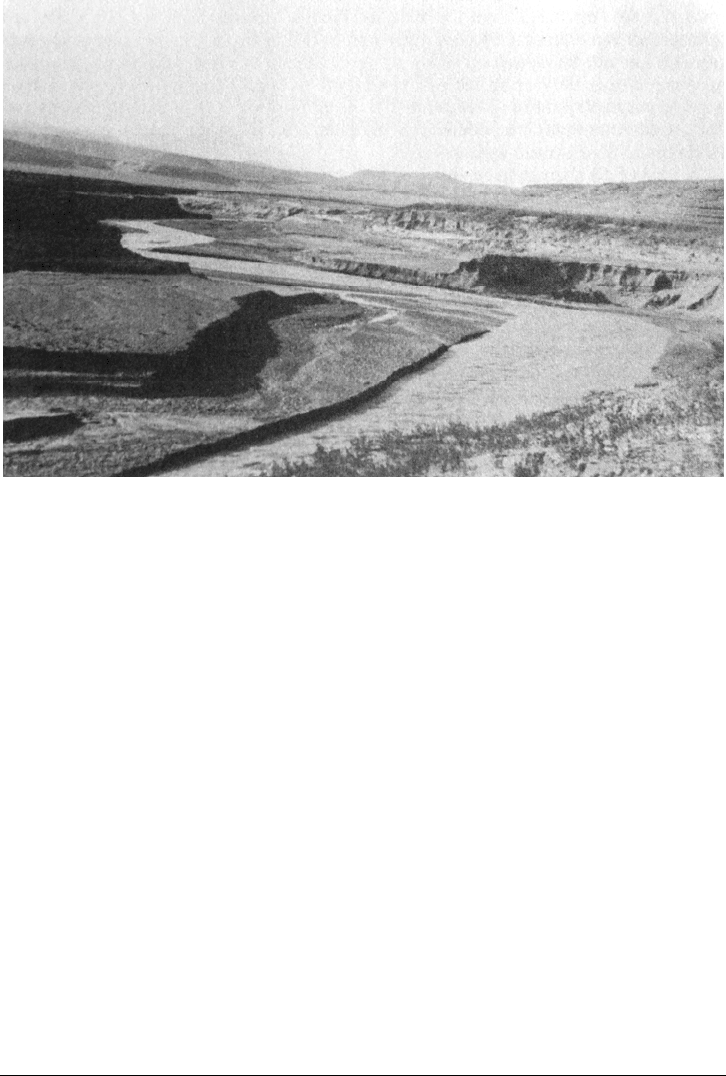
CASE STUDY: SEFID-RUD RESERVOIR, IRAN 23.25
FIGURE 23.23 Stabilized channel configuration in the middle reach of the diversion channel.
N
otice the flat terraces created by clay layers in the deposits. (E. Tolouie).
neede
d to make effective predictions, and the presence of layered cohesive sediments and
the presence of some cohesive material in nominally noncohesive deposits are important
factors which significantly complicate the analysis.
23.6.6 Long-Term Capacity
Tolouie (1993) modeled the effect of flushing alone, as well as the use of diversion
channels to control sediment accumulation at Sefid-Rud. From field experience, it
was assumed that one flushing season would be adequate to scour a diversion channel to
a stable configuration. Thus, at the beginning of each flushing season a new diversion
channel pilot channel would be dug and eroded. It was assumed that the emptying
period would begin in October, but diversion into the new channel would not
begin until November of each year. At Sefid-Rud it was estimated that about 90
percent of the original reservoir capacity (1600 Mm
3
) can be recovered and
maintained through a combination of flushing and diversion channels. Figure 23.11
compares 30-year projections of storage capacity for flushing alone against flushing
plus supplemental erosion using longitudinal diversion channels, with 75 percent of the
flushing season inflow used to erode the new channels.
23.7 ECONOMIC ANALYSIS
An economic analysis was performed to compare a variety of sediment management
alternatives (Tolouie, 1989). The analysis started in the year 1963 (first year of dam
operation) and considered the capital cost of the dam and appurtenant facilities as sunk
costs and thus excluded from the analysis. Income streams from both irrigation and
hydropower were either reduced or increased over time because of the change in
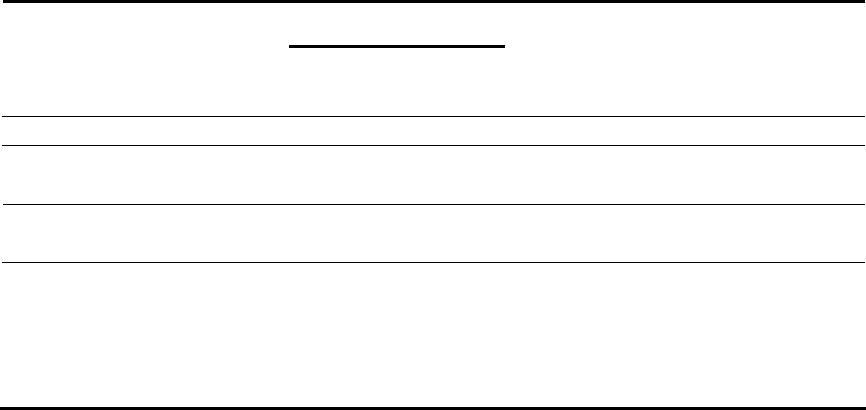
CASE STUDY: SEFID-RUD RESERVOIR, IRAN 23.26
reservoir storage volume caused by sediment accumulation or removal. Hydropower
benefits were eliminated during the period October through February in the alternatives
which incorporated flushing. At Sefid-Rud the elimination of hydropower benefits over
this period is not a major economic consideration, since irrigation benefits are more than
10 times the benefit from hydropower
A total of 10 alternatives were examined, divided among four basic categories. The
first category (alternative 1) was continued conventional operation with no sediment
management. The second category (alternatives 2 and 3) considered only the operation of
bottom outlets to vent turbidity currents, discharging as much water as possible from the
bottom of the reservoir rather than over high-level spillways. The third category
(alternatives 4 and 5) considered flushing with or without discharge through bottom
outlets. The fourth category considered flushing plus additional measures. The
alternatives are summarized in Table 23.5. The economic analysis was performed over a
period that started in 1963 and ended when 75 percent of the capacity had been lost, or
after 100 years. Under the first two categories (alternatives 1, 2, and 3) the reservoir is
rendered unusable by sedimentation within 100 years, but under all others reservoir life
exceeds the 100-year period used for the analysis. The reservoir was assumed unusable
when 75 percent of its original capacity was sedimented. Construction of diversion
channels was not considered in this analysis because this technique had not been
developed and tested when the economic analysis was undertaken. All economic values
were expressed in terms of 1963 dollars and the present value of all future income and
costs were determined for a discount rate of 4 percent. Under all cases (except alternative
1), reservoir desilting was assumed to begin in the eighteenth year of reservoir
TABLE 23.5 Economic Analysis of Sediment Control Alternatives at Sefid-Rud
Spillage through bottom
outlets
Alternative Category
Vol. of
annual
spillage,
Ave. susp.
sediment
conc., g/L
Ave.
annual
desilting
efficiency,
Reservoir
half-life,
years
Base year
cost of
measures,
million $
Base year
cumulative
net benefit,
million $
I Normal operation 0 0 25 27 - 2458
2 Sluicing surplus water 50 10 36.3 28 2515
3 during spring floods 90 15 56.8 31
20
2705
4 0 0 96.5 - - 3079
5
Flushing*
90 15 105.9 - 20 3122
6 Flushing,
60 g/L
0 0 114.1 - 46.3 3135
7 with coin-
65 g/L
0 0 121.9 - 35.9 3167
8 plementary
70 g/L
0 0 129.7 - 30.8 3185
9 measures
70 g/L
0 0 133.1 - 47 3180
1 0
75 g/L 0 0 137.1 - 26 3198
*Shows average sediment concentration of flushing discharge
Source: Tolouie (1989).
`

CASE STUDY: SEFID-RUD RESERVOIR, IRAN 23.27
operation, and all alternatives incorporate the continual loss of reservoir storage through
the seventeenth year under normal operation. Because of the high rate of sedimentation
at this reservoir, it was considered economically advantageous to intensely manage the
reservoir for sediment control to stabilize its capacity. If this same economic analysis
were performed with the present time as the base year, instead of 1963 when the reservoir
entered into operation, the net benefit from flushing would be much higher than shown in
Table 23.5.
23.8 CLOSURE
Tolouie (1993) concluded that flushing plus longitudinal diversion is an inexpensive
and practical method to recover and maintain reservoir capacity which can be
implemented using simple technology at sites where flushing is possible. With a
combination of flushing and diversion, it may be possible to maintain reservoir
capacity equivalent to a C:I ratio of 0.3. Because high sediment release efficiency is
obtained during the first 3 years of flushing, diversion should not be undertaken
during this initial flushing period. While the amount of sediment that can be removed
increases as a function of the flow diverted into the channels, experience at Sefid-Rud
suggests that, because of operational constraints, it will probably not be possible to divert
more than 75 percent of inflow during the flushing period into diversion channels.
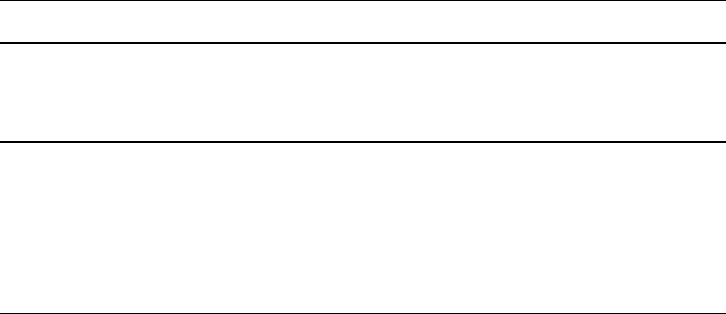
CHAPTER 24
CASE STUDY: SANMENXIA
RESERVOIR
24.1 INTRODUCTION
The Yellow River (Huanghe) drains China's semiarid loess plateau, which is composed
of thick aolean deposits of silty soils. As a result of high erodibility and gullying,
intensive land use, inadequate soil conservation practices, and virtually limitless
sediment supply, the sediment load carried through the Samen Gorge by the Yellow
River is the greatest of all the world's rivers. After passing through the gorge reach,
the river has historically deposited about 33 percent of its load on the alluvial
floodplain and another 43 percent on the delta prior to discharging to the Yellow
Sea (Long and Zhang, 1981).
The Sanmenxia Darn, constructed during 1957-1960, is the first dam built on the
middle reach of the silt-laden Yellow River. The 96-m-high concrete gravity dam
controls a drainage area of 688,400 km
2
, or 92 percent of the entire Yellow River basin
(Fig. 24.1). The maximum historical floods at the dam site were 22,000 m
3
/s in 1933
and 36,000 m
3
/s in 1843. The dam was planned as a multiple-use project for flood
control, hydropower, irrigation, navigation, and ice jam control. It was originally
designed with a full reservoir level of 360 m and 64.7 km
3
of storage, inundating 3500
km
2
of floodplain and requiring the relocation of 870,000 persons. To reduce these
impacts, the dam was built to an elevation of 350 m with a maximum pool elevation
of 340 m in the initial stage of operation. Construction began in 1957, the river was
closed in November 1958, and the dam was completed in September 1960. According
to the original plans, two sediment control measures were to be implemented. (1) The
reservoir was to continuously impound water and release 35 percent of the sediment
inflow as turbidity currents through 12 outlets at 300 m. (2) Total sediment inflow was to
be reduced 3 percent annually by soil conservation works, resulting in a 60 percent
reduction of sediment inflow after 20 years. These numbers subsequently proved to be
extremely optimistic. Furthermore, the amount of sediment inflow and the severity of
upstream backwater deposition had also been underestimated (Dai, 1991).
Severe sediment accumulation problems became evident immediately after
impounding began; 1.8 billion metric tons of sediment accumulated during the first 18
months after closure, representing a release efficiency of only 7 percent (93 percent
trap efficiency). Sedimentation not only threatened to eliminate all project benefits in
a short time, but sediment deposits were also raising the bed elevation and flood levels in
the Yellow River as far as 260 km upstream of the dam. This threatened additional
agricultural lands and riverside industrial areas in the city of Xian located on the
Wei River, and it potentially required relocation of an additional million persons.
These were unacceptable impacts. The project could not even be abandoned without
removing the dam, and establishment of a sediment balance became the highest
priority objective.
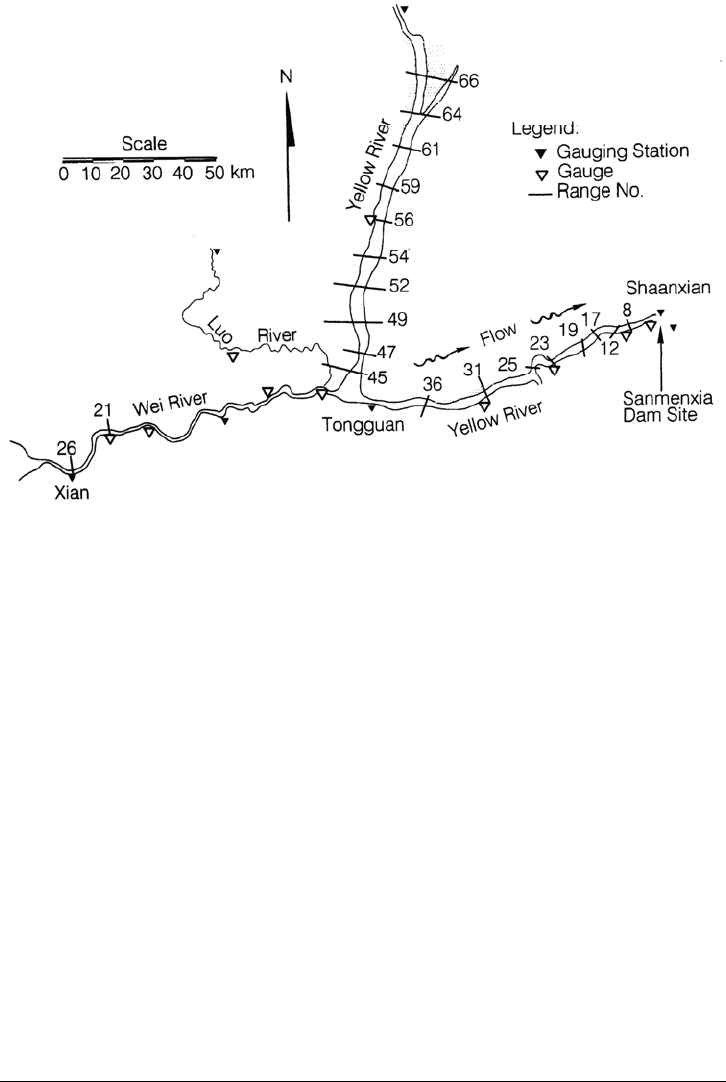
CASE STUDY: SANMENXIA RESERVOIR 24.2
FIGURE 24.1 Location map of Sanmenxia Reservoir, on the Yellow River, China (after Lon
g
and Zhang, 1981).
To achieve balance between sediment inflow and outflow, the dam was extensively
reconstructed to provide high-capacity bottom outlets and reservoir operation was
substantially changed. Sediment balance was finally achieved after 1970, making
Sanmenxia the first major reservoir in the world where this was accomplished (Fig.
24.2). This project not only demonstrates the perils of giving inadequate consideration
to sediment management in the planning and design of a reservoir, but it also
shows that a sediment balance can be achieved across an impounded reach even in a
large reservoir on a river with an extreme sediment load. Although project benefits are
much smaller than the unrealistic values originally planned, the benefits are permanent.
A principal objective of dam construction, flood detention to protect the downstream
floodplains, has been achieved.
This case study describes sediment management strategies that were implemented
and also the complex river sedimentation behavior that was influenced by dam
construction. Because of the extreme silt loads and the highly erodible nature of the
alluvial silts, river adjustment processes occur quickly in this system and are useful
indicators of the types of responses that may occur in other systems over longer time
periods. This case study is based on the second author' s involvement in this project
since the 1950s, site visit and interviews by the first author in 1987, plus the cited
literature.
24.2 HYDROLOGIC SETTING
Most rainfall in central China occurs in late summer, generating surface runoff, erosion,
and extremely high rates of sediment transport during July and August. Before dam
construction, the annual runoff at Shaanxian station near the dam site averaged 43,100
Mm
3
and the sediment load consisted mostly of silts with a median grain diameter
d
50
of 0.03 mm. Sediment discharge averaged 1.6 billion tons per year, equivalent to an
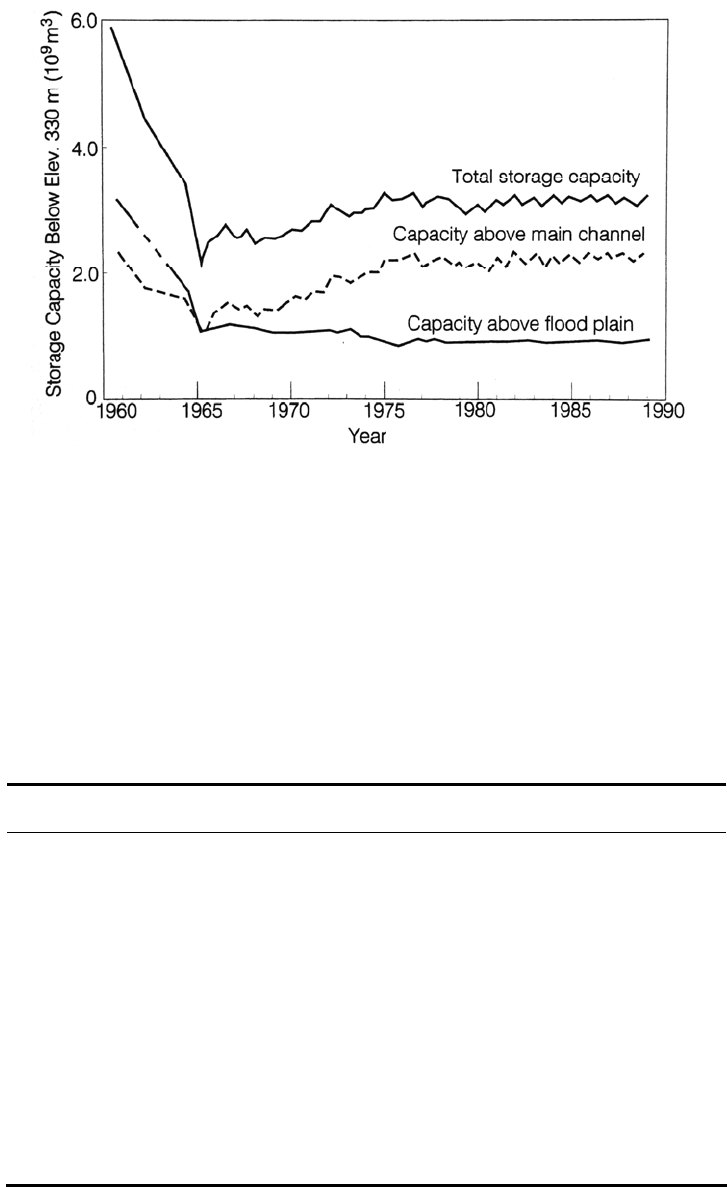
CASE STUDY: SANMENXIA RESERVOIR 24.3
annual sediment yield of 2300 t/km
2
and a mean suspended-sediment concentration of 38
g/L. July and August account for about 60 percent of total sediment yield but only 30
percent of the annual runoff (Table 24.1). Sediment concentrations as high as 941 g/L
have been measured in the Yellow River near the dam site.
FIGURE 24.2 Summary of the sedimentation history of Sanmenxia Reservoir (after Pan,
1990). The initiation of emptying and flushing in 1966 using large-capacity low-level outlets
recovered storage capacity in the main channel area by scouring of the deposits. In contrast, the
floodplain areas continued to accumulate sediment and lose capacity, although at a greatly
reduced rate.
TABLE 24.1
Monthly Variation of Discharge and Sediment Transport at
Shaanxian Hydrologic Station, 1919-1959
Monthly mean
Discharge,
m3/s
Sediment
transport, 10
6
t
Sediment
concentration, kg/m3
January 463 12.1 9.8
February 570 14.4 10.4
March 768 26.5 I 2.9
April 855 27.8 12.5
May 855 31.9 13.9
June 1080 79.8 28.5
July 2230 356 59.6
August 2880 611 79.2
September 2560 259 39.1
October 2100 121 21.4
November 1240 48.9 15.2
December 570 16.8 11.0
Yearly means 1353 1605 37.6
Source: Shaanxi Provincial Institute of Hydraulic Research and Qinghua University (1978).

CASE STUDY: SANMENXIA RESERVOIR 24.4
Sanmenxia Dam is situated in the downstream portion of the gorge reach of the
Yellow River and upstream of flood-threatened plains. The dam site is 114 km
downstream of the ancient stronghold of Tongguan, situated immediately downstream
of the confluence of the Yellow and Wei Rivers (Fig. 24. 1 ). The Yellow River is only 1
km wide at Tongguan, but upstream it expands to more than 10 km in width at the
confluence with the Wei River. The constricted river reach at Tongguan acts as a
hydraulic control section that influences river stage, flow velocity, and thus the
sediment transport capacity in the reaches of both the Yellow and Wei Rivers upstream
of Tongguan. During floods, the stage at Tongguan rises rapidly and creates
backwater conditions extending tens of kilometers upstream, thereby limiting
sediment transport capacity and promoting sediment deposition upstream of the
constricted Tongguan reach. This backwater reduces flow velocity and causes
sediments to deposit in both the Yellow and Wei Rivers. At the end of the flood
season, lower flows and reduced water levels cause these deposits to be scoured and
moved downstream into the narrow Tongguan reach. Thus the bed elevation at
Tongguan varies seasonally; it is scoured by high-velocity flow during the flood
season, and during the nonflood season it is refilled by sediment that was deposited in
the upstream reach during the preceding flood. Historical records indicate that the
average bed elevation at Tongguan aggraded about 14 m during the 1800 years
preceding dam construction, or about 0.008 m/yr, but no net change in the bed
elevation at Tongguan was detected between 1948 and 1960. However,
impounding by Sanmenxia Dam caused the bed elevation at Tongguan to rise 4.5
m between 1960 and 1961. Because the bed elevation and stage at Tongguan exert
hydraulic control on both the Yellow and Wei Rivers upstream, the control of
sediment accumulation at Tongguan is the key to limiting deposition and controlling
backwater further upstream.
24.3 SUMMARY OF SEDIMENT CONTROL MEASURES
Water and sediment at Sanmenxia are regulated to achieve the following objectives:
1. Control extreme floods;
2. Provide irrigation, ice jam control, and power supply benefits;
3. Limit upstream backwater deposition above Tongguan;
4. Limit the amount of sediment deposition in the Lower Yellow River downstream of
the dam; and
5. Preserve long-term useful storage capacity.
Sediment controls were implemented in stages, and two decades were required to
bring sediment inflow and discharge into balance and control the bed elevation at
Tongguan. This was achieved by extensively reconstructing the darn to increase
the discharge capacity of low-level outlets, and by changing the operating rule to
impounding during the nonflood season, and emptying and flushing during the flood
season from July to October each year, thereby limiting deposition and scouring
out deposited sediments.
The general layout of Sanmenxia Dam showing the location of deep sluices used
for sediment release is presented in Fig. 24.3. Upstream and downstream views of the
dam during drawdown and flushing are shown in Fig. 24.4, and a view of the top of the
darn showing vertical sluice gates and the gantry for gate placement is presented in Fig.
24.5. The capacities of sediment sluices installed in the dam are summarized in Table
24.2.

CASE STUDY: SANMENXIA RESERVOIR 24.5
FIGURE 24.3 General layout of Sanmenxia Dam showing the location of deep sluices and
penstocks used for sediment release (after Chinese National Committee on Large Dams, 1987).
FIGURE 24.4 (a) Upstream face of Sanmenxia Dam during sediment flushing. showing low
pool and low level sluices in the foreground (G. Morris).
